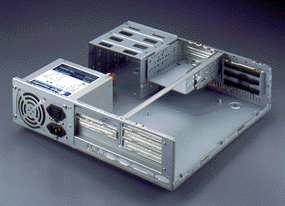[ The PC Guide | Systems and Components Reference Guide | System Case | Form Factors ]
LPX / Mini LPX Form Factor
Without knowing it, retail PC customers have made LPX one of the most popular form factors of the last decade. Most PCs sold in slimline or "low profile" cases in the late 1980s and early 1990s use the LPX form factor, or a variant of it. Originally developed by hard disk manufacturer Western Digital Corporation back when they made motherboards, the goal of the LPX design was simple: to reduce the size and cost of the PC system box. The key design decision in LPX that enables the dramatic reduction of the size of the case is the creation of a riser card that plugs into the motherboard. Expansion cards then plug into the riser card, parallel to the motherboard. By doing this, the case no longer has to be tall enough to accommodate the height of an expansion card. See the discussion of the LPX motherboard form factor for more details on the LPX design.
|
Rear view of one of Enlight's first cases, an LPX
desktop unit. The distinctive |
Image � Enlight Corporation |
One problem with the LPX form factor is that it is only a "pseudo-standard"; it was never formalized into a hard standard, the way for example ATX and NLX have been. Many companies make systems that use slimline cases and LPX-style motherboards and power supplies, but they often differ slightly in size, shape, or other characteristics. This means you cannot expect to move a power supply from say, a Compaq LPX system into a similar-looking Packard Bell system. LPX systems are essentially proprietary.
There is one innovation of the LPX form factor that has carried forward into the more modern designs: the use of integrated I/O connectors, and holes provided for them in the system case. The lack of this design in the Baby AT form factor led to increased cost and time of assembly, a problem avoided with the newer form factors.
LPX cases are usually used with LPX form factor power supplies, which are sometimes called "slimline" supplies because LPX systems are often referred to by their "slimline" style.
![]() Next: NLX
Form Factor
Next: NLX
Form Factor
| The PC Guide
(http://www.PCGuide.com) Site Version: 2.2.0 - Version Date: April 17, 2001 © Copyright 1997-2004 Charles M. Kozierok. All Rights Reserved. |
Not responsible for any loss resulting from the use of this site. Please read the Site Guide before using this material. |
